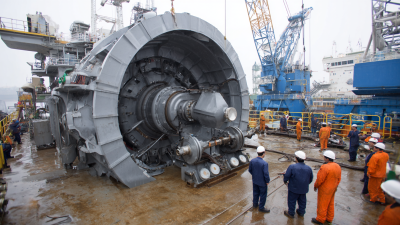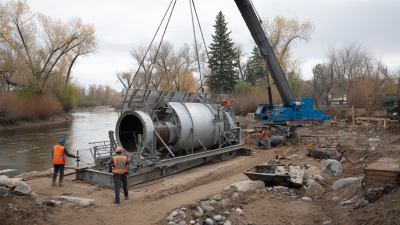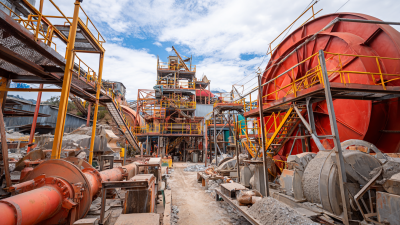

In the fast-moving world of oil and gas, tweaking Lab Hydrocyclone setups has really become a big deal if you want better separation and smoother operations. I mean, a recent report mentioned that hydrocyclones are gaining popularity because they do a pretty awesome job at sorting particles of different sizes and densities. That leads to not only getting more recovery out of the process but also cutting down on costs. Companies like Shanghai Shangjiang Petroleum Engineering Equipment Co., Ltd. are really leading the charge here — constantly coming up with new cyclone technology and innovative products to meet industry needs. As everyone’s looking for more efficient separation tools, having solid strategies to optimize Lab Hydrocyclones can seriously boost productivity and sustainability. Honestly, these insights are super valuable if you want to stay ahead of the game in 2023 and beyond.

Getting a good handle on how hydrocyclones work in lab settings is pretty key if you wanna make them run more efficiently. Basically, they use centrifugal force to separate particles in a fluid—so bigger or denser stuff gets pushed to the outside, while lighter or smaller particles stay in the center. Recently, there's been some pretty cool progress, like designing new types of radial hydrocyclones. These new designs really help improve the flow conditions inside, which means they do a better job at separating oil from water. In fact, data shows some of these new setups can boost separation efficiency quite a bit—sometimes by over 20% compared to the older models. Pretty impressive, right?
And it doesn’t stop there. Scientists are also looking into optimizing the overall structure of these hydrocyclone coalescers. Using methods like the response surface approach, for instance, they can tweak things like inlet angles and the size of tiny hydrocyclones—what you might call mini-hydrocyclones—to get better droplet collision and separation. This is especially useful in wastewater treatment, where the whole process might only take a few seconds inside the device. When pollutants are being effectively removed, it proves just how powerful and adaptable hydrocyclones are, not just in labs but also in big industrial setups. They’re increasingly playing a pretty vital role in advanced separation processes—pretty neat!

When it comes to designing hydrocyclones, there are a few key factors that really influence how well they work. Lately, studies have pointed out just how important flow conditions are—basically, if the feed fluctuates too much, it can mess up the separation process.
For example, some recent experiments and simulations on adjustable overflow hydrocyclones show that keeping the feed steady can seriously boost how effectively they separate particles. It kind of drives home the idea that paying close attention to inlet settings is super important if you want your hydrocyclone to perform at its best.
On top of that, new design tweaks like adding thin concentric rings inside the cylindrical section have shown some pretty encouraging results. They help cut down on fines that sneak past and improve overall classification. When you combine these kinds of design changes with multi-objective optimization—basically, tweaking different performance goals at once—you can really crank up efficiency. Recent research has also looked into how the position and number of inlets affect flow patterns, highlighting just how much the shape and layout matter for better performance.
As the industry keeps moving forward, blending traditional physical models with data-driven approaches is looking like a smart move. It helps boost separation efficiency, especially in tricky applications like water treatment or complex particle separation. The key is to keep refining these design details—by doing so, operators can enjoy more reliable, more efficient hydrocyclone systems that do the job well day after day.
When you're looking to really boost the efficiency of lab hydrocyclones, one thing you can’t overlook is making sure the feed conditions are just right. These devices work on the principle of centrifugal force, but how well they perform depends a lot on how you prep the feed beforehand. Getting the particle size and distribution dialed in is super important — if there are way too many fines or giant particles in there, you’re probably gonna see a drop in separation efficiency and maybe even wear out the parts faster.

Plus, keeping flow rates steady and ensuring the feed density is spot-on are key steps to getting the best results from your hydrocyclone. If the pressure fluctuates, it can stir up turbulence, making the separation unpredictable. Also, don’t forget to check that the solids percentage in the feed isn’t too high — going overboard can cause clogging and slow things down. By paying attention to these feed details, you can really optimize performance and get better separation results. It’s all about small tweaks that make a big difference.
Keeping hydrocyclones in good shape is pretty important if you want them to perform well in your lab. Doing regular maintenance isn’t just about making them last longer—it also helps you get consistent, reliable results. A good starting point is to routinely check the parts of the hydrocyclone. Look out for any signs of wear on the liner—if that’s damaged, it can really mess with how well it separates materials. Also, don’t forget to peek at the inlet and outlet. Make sure they’re not clogged or leaking because even small blockages can throw off the flow and hurt performance.
Another big thing is controlling the operating conditions. Make sure your feed slurry isn’t too thick or too thin, because overloads can cause all sorts of problems. It’s also worth calibrating the pressure settings regularly since wrong pressure levels can lead to poor separation too. Keeping a simple log of what maintenance you do and how the equipment is performing over time can be super helpful. It lets you spot potential issues early on before they become big problems. Basically, if you stick to these tips, you’ll keep your hydrocyclone running smoothly and reliably—no stress, just good results.
Lately, there's been some pretty exciting progress in the way hydrocyclones are designed, and honestly, it’s really stepping up how well separation works in labs. Engineers and scientists are now using computational fluid dynamics—yeah, CFD—to fine-tune the shape and structure of these devices. It’s like having a virtual test run: they can model how the flows move and see how particles act, which helps them come up with better designs. You’ve probably heard about newer styles like tapered hydrocyclones or those with dual stages—they give much more control over sorting particles by size and, in the end, help recover more valuable stuff. Pretty cool, right?
On top of that, tech’s moving fast—smart sensors and real-time monitoring are now a game changer. These tiny gadgets keep tabs on things like pressure and flow all the time, so operators can tweak the process on the fly instead of waiting for problems. Plus, with some machine learning thrown into the mix, it’s even possible to predict when something might break or need maintenance before it actually happens. That means less downtime and more reliable results. All these tech advances are really helping labs not only get more consistent outcomes but also speed things up quite a bit—it’s pretty remarkable how modern tools are pushing hydrocyclone efficiency to the next level.
When it comes to getting the best performance out of a hydrocyclone in the lab, it’s pretty important to keep an eye on a few key metrics. First off, you wanna look at the particle size distribution of your feed—this really hits the sweet spot for how well the hydrocyclone can separate stuff. Running a particle size analysis here is super helpful; it lets you tweak the design to get it just right. Oh, and don’t forget to watch the pressure drop across the unit. If the pressure stays steady, that’s usually a good sign that everything’s running smoothly. But if it starts fluctuating, that could mean there’s a clog or something isn’t quite right, and you’ll want to check it out.
Here’s a tip: make sure you’re doing regular maintenance—clean it up, check those wear parts. Doing this can save you some serious headaches down the line, like unexpected standstills. Also, keep an eye on your underflow and overflow settings—they’re adjustable based on what the data tells you. Fine-tuning these can really help optimize performance based on your current process needs. Focusing on these little details in your evaluations will definitely help you hit those efficiency goals you’re after in your experiments.
| Tip Number | Optimization Tip | Performance Metric | Expected Improvement (%) |
|---|---|---|---|
| 1 | Optimize inlet design | Flow rate uniformity | 15% |
| 2 | Adjust cut size | Particle size distribution | 20% |
| 3 | Maintain proper pressure | Vortex finder efficiency | 10% |
| 4 | Use correct underflow valve settings | Underflow concentration | 18% |
| 5 | Regular maintenance and cleaning | Clogging rate | 25% |
| 6 | Optimize particle feed size | Separation efficiency | 30% |
| 7 | Monitor and adjust slurry density | Overall recovery rates | 12% |
| 8 | Implement advanced monitoring systems | Real-time performance metrics | 22% |
: Key design factors include flow conditions, feed stability, geometrical configurations, and innovative design modifications like thin concentric rings. These factors significantly impact classification efficiency and separation outcomes.
Consistent feed conditions are vital because fluctuations in flow rates and pressure can create turbulence, adversely affecting separation efficiency and leading to unpredictable outcomes.
The particle size distribution directly influences separation efficiency; improper sizing can cause loss of efficiency and increased wear on hydrocyclone components.
Regular maintenance should include cleaning and inspecting wear components, as well as monitoring and adjusting the underflow and overflow configurations based on real-time data.
Innovative designs, such as the introduction of thin concentric rings, have been shown to minimize fines bypass and improve overall classification capability, leading to enhanced efficiency.
Integrating both mechanistic and data-driven models allows for continuous optimization of design parameters, enhancing separation efficiency—especially in complex applications like water treatment.
Feed that contains too many fines or oversized particles can lead to loss of separation efficiency and increased wear on hydrocyclone components.
Operators should ensure that the solids content in the feed stays within the recommended range to avoid clogging and maintain throughput.
Fluctuations in pressure drop may suggest blockages or inefficiencies, while a stable profile indicates effective separation.
Assessing performance metrics, such as particle size distribution and pressure drop, allows for tailored adjustments to the hydrocyclone design, significantly enhancing overall efficiency.
When it comes to the oil and gas industry, getting the most out of lab hydrocyclones is pretty important for making sure separation processes run smoothly. In this post, I’ll walk you through some of the key factors that really influence how well these devices perform—like how they work at their core and what design features matter most. Honestly, paying attention to the right feed conditions is a game-changer if you want top efficiency, and regular maintenance is the secret to keeping things running without hiccups.
We also take a look at some of the latest tech breakthroughs that are making hydrocyclone designs smarter and more effective. By keeping an eye on performance metrics and doing some solid analysis, operators can make better decisions to boost their processes. Here at Shanghai Shangjiang Petroleum Engineering Equipment Co., Ltd., we’re all about pushing forward with new cyclone separation technologies, so our clients can stay ahead with the latest improvements in lab hydrocyclone performance.






